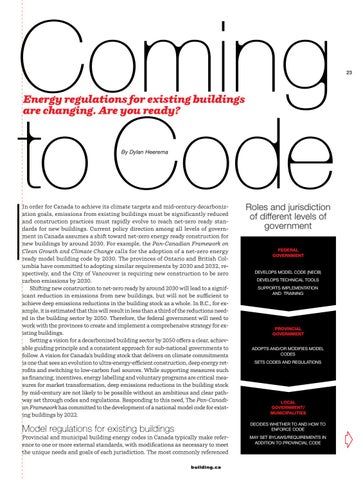Coming to Code
23
Energy regulations for existing buildings are changing. Are you ready?
By Dylan Heerema
I
In order for Canada to achieve its climate targets and mid-century decarbonization goals, emissions from existing buildings must be significantly reduced and construction practices must rapidly evolve to reach net-zero ready standards for new buildings. Current policy direction among all levels of government in Canada assumes a shift toward net-zero energy ready construction for new buildings by around 2030. For example, the Pan-Canadian Framework on Clean Growth and Climate Change calls for the adoption of a net-zero energy ready model building code by 2030. The provinces of Ontario and British Columbia have committed to adopting similar requirements by 2030 and 2032, respectively, and the City of Vancouver is requiring new construction to be zero carbon emissions by 2030. Shifting new construction to net-zero ready by around 2030 will lead to a significant reduction in emissions from new buildings, but will not be sufficient to achieve deep emissions reductions in the building stock as a whole. In B.C., for example, it is estimated that this will result in less than a third of the reductions needed in the building sector by 2050. Therefore, the federal government will need to work with the provinces to create and implement a comprehensive strategy for existing buildings. Setting a vision for a decarbonized building sector by 2050 offers a clear, achievable guiding principle and a consistent approach for sub-national governments to follow. A vision for Canada’s building stock that delivers on climate commitments is one that sees an evolution to ultra-energy-efficient construction, deep energy retrofits and switching to low-carbon fuel sources. While supporting measures such as financing, incentives, energy labelling and voluntary programs are critical measures for market transformation, deep emissions reductions in the building stock by mid-century are not likely to be possible without an ambitious and clear pathway set through codes and regulations. Responding to this need, The Pan-Canadian Framework has committed to the development of a national model code for existing buildings by 2022.
Roles and jurisdiction of different levels of government FEDERAL GOVERNMENT
DEVELOPS MODEL CODE (NECB) DEVELOPS TECHNICAL TOOLS SUPPORTS IMPLEMENTATION AND TRAINING
PROVINCIAL GOVERNMENT ADOPTS AND/OR MODIFIES MODEL CODES SETS CODES AND REGULATIONS
LOCAL GOVERNMENT/ MUNICIPALITIES DECIDES WHETHER TO AND HOW TO ENFORCE CODE
Model regulations for existing buildings
Provincial and municipal building energy codes in Canada typically make reference to one or more external standards, with modifications as necessary to meet the unique needs and goals of each jurisdiction. The most commonly referenced
MAY SET BYLAWS/REQUIREMENTS IN ADDITION TO PROVINCIAL CODE
building.ca
BLD OctNov 17.indd 23
17-10-17 9:30 AM
